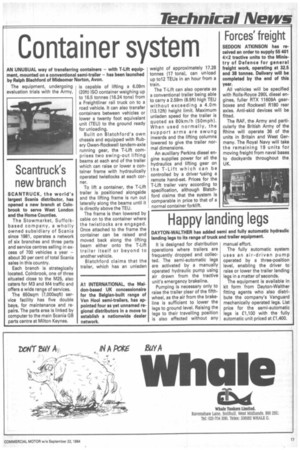Container system
Page 19

If you've noticed an error in this article please click here to report it so we can fix it.
AN UNUSUAL way of transferring containers — with T-Lift equipment, mounted on a conventional semi-trailer — has been launched by Ralph Blachford of Midsomer Norton, Avon.
The equipment, undergoing evaluation trials with the Army, is capable of lifting a 6.09m (20ft) ISO container weighing up to 16.5 tonnes (16.24 tons) from a Freightliner rail truck on to a road vehicle. It can also transfer containers between vehicles or lower a twenty foot equivalent unit (TEU) to the ground ready for unloading.
Built on Blatchford's own chassis and equipped with Rubery Owen-Rockwell tandem-axle running gear, the T-Lift comprises two swing-out lifting beams at each end of the trailer which can raise or lower a container frame with hydraulically operated twistlocks at each corner.
To lift a container, the T-Lift trailer is positioned alongside and the lifting frame is run out laterally along the beams until it is directly above the TEU.
The frame is then lowered by cable on to the container where the twistlocks are engaged. Once attached to the frame the container can be raised and moved back along the lifting beam either onto the T-Lift trailer itself or beyond to another vehicle.
Blatchford claims that the trailer, which has an unladen weight of approximately 17.28 tonnes (17 tons), can unload up to12 TEUs in an hour from a train.
The T-Lift can also operate as a conventional trailer being able to carry a 2.59m (8.5ft) high TEU without exceeding a 4.0m (13.12ft) height limit. Maximum unladen speed for the trailer is quoted as 80km/h (50mph). When used normally, the support arms are swung inwards and the lifting columns lowered to give the trailer normal dimensions.
An auxiliary Perkins diesel engine supplies power for all the hydraulics and lifting gear on the T-Lift which can be controlled by a driver 'using a remote hand-set. Prices for the T-Lift trailer vary according to specification, although Blatchford claims that the system is comparable in price to that of a normal container forklift.




























































































